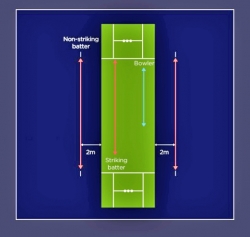ECB RETURN TO CRICKET PLAN FOR STEP 4 JULY 2020
Date: 9th July 2020
The detail from ECB as to how we do it.
Adaptations for all outdoor cricket activity, applicable to players, spectators, volunteers, clubs, coaches & officials in Step 4 of the ECB Return to Cricket Roadmap
This plan provides measures that should be taken by players, clubs, officials, volunteers, coaches, and spectators before, during and after all outdoor cricket activity as well as specific advice relating to clubs, coaches, match-play, and children’s activity. It should be read in conjunction with the latest UK Government guidance and the ECB’s guidance on Getting your Clubhouse and Ground Ready for Step 4 here. https://i.emlfiles4.com/cmpdoc/0/8/7/0/3/1/files/88555_getting-your-clubhouse-ready-for-opening.pdf
For all activity, the relevant UK Government social distancing guidance should be adhered to at all times (including throughout warm-ups) except in the following limited circumstances during competitive play in England only where social distancing of 1m+ is permitted: 1) wicket keepers standing up to the stumps and 2) distance between slip fielders. In England social distancing, guidance can be found here . https://www.gov.uk/government/publications/staying-alert-and-safe-social-distancing and in Wales social distancing guidance can be found here https://gov.wales/coronavirus-social-distancing-guidance
This document refers to current UK Government guidance for England only and is subject to change in response to the current COVID-19 Alert Level, community prevalence of COVID-19 and/or to reflect additional or updated UK Government guidance. Players living in Wales intending to play in England should familiarise themselves with this guidance.
Prior to all cricket activity
-
All participants (players, coaches, officials, volunteers and spectators) should check for symptoms of COVID-19. In line with current UK Government Guidance, if an individual is symptomatic and/or living in a household with a possible COVID-19 infection they should remain at home and follow UK Government guidance. In addition, any participants who have been asked to isolate by NHS Test and Trace because they are a contact of a known COVID-19 case, must not exercise outside their home or garden and must not exercise with others.
-
Participants should follow UK Government guidance on shielding and protecting people who are clinically extremely vulnerable from COVID-19 (found here) if it applies to them.
-
Participants should comply with all public health restrictions and avoid high risk behaviour outside the sports setting to reduce the risk to their fellow participants when they do attend a cricket club or venue.
-
Personal hygiene measures should be carried out at home before and after cricket activity.
-
Participants should bring their own hand sanitiser where possible and maintain strict and frequent hand hygiene measures at all times.
-
Participants should follow UK Government guidance on best practice for travel, including minimising the use of public transport and limiting car sharing (found here). https://www.gov.uk/guidance/coronavirus-covid-19-safer-travel-guidance-for-passengers
-
Use of the clubhouse, changing rooms and toilets should adhere to the latest UK Government guidance.
-
For advice on reducing the risk of infection when outside your home see here. https://www.gov.uk/government/publications/staying-safe-outside-your-home/staying-safe-outside-your-home
-
Club representatives should ensure that the facility is compliant with current UK Government legislation including legislation and guidance related to COVID-19. A risk assessment should have been completed and risk mitigation measures put in place and monitored in accordance with the ECB’s guidance on Getting your Clubhouse and Ground Ready for Step 4.
-
Club representatives should make all participants aware of expected social distancing and hygiene measures during play and whilst on site. https://i.emlfiles4.com/cmpdoc/0/8/7/0/3/1/files/88555_getting-your-clubhouse-ready-for-opening.pdf
-
Clubs should strictly limit the time spent congregating at a venue before activity begins. Meet-up times should reflect this. Participants should arrive changed and ready to begin the warm-up, if possible.
-
Club representatives should make all participants aware of the increase in transmission risk associated with partaking in even socially distanced group activity and should ensure that all participants are clear that they are opting to participate in cricket activity.
-
For advice on reducing the risk of infection when outside your home, see here. https://www.gov.uk/government/publications/staying-safe-outside-your-home/staying-safe-outside-your-home
During all cricket activity
-
Cricket activity must take place outdoors only.
-
11-a-side cricket can return as long as groups are limited to a maximum of 30 participants, including coaches and officials.
-
Participants should enter the site and prepare their personal equipment whilst maintaining social distancing.
-
Where possible players should limit sharing of equipment. If they do, they must practise strict hand hygiene before and after use and the equipment must be cleaned before use by another person. More information is available here. https://www.gov.uk/government/publications/coronavirus-covid-19-guidance-on-phased-return-of-sport-and-recreation/guidance-for-the-public-on-the-phased-return-of-outdoor-sport-and-recreation
-
No sweat or saliva is to be applied to the ball at any time.
-
All participants should sanitise their hands prior to the start of the activity.
-
Hand sanitiser should be used at all breaks in activity and prior to consuming any food or drinks.
-
Players should refrain from spitting or rinsing out their mouths.
-
In line with current UK Government guidance, clubs should not prepare food for participants. Individuals should bring their own food and drink for ‘teas’ or practice. Water bottles or other refreshment containers should not be shared.
After all cricket activity
Additional Advice for Clubs & Club Representatives
Preparation of the cricket venue
A risk assessment should have been completed and risk mitigation measures put in place and monitored.
-
On any day of the activity, club representatives and volunteers should ensure that all COVID-19 measures are in place according to the club operating and safety plans, whilst maintaining social distancing – developing your own ‘opening up checklist’ is helpful for this. This should include:
-
Set-up of public health operating procedures and access signage.
-
Set-up of cricket facility including all ground safety requirements.
-
The duty of care which the club already owed remains and therefore other matters such as First Aid must continue to be provided. First Aid equipment (including AEDs where available) and suitable PPE for First Aid must be made available. Advice on First Aid during the COVID pandemic is available from St John Ambulance. https://www.sja.org.uk/get-advice/first-aid-advice/covid-19-advice-for-first-aiders/
-
Clubs should make hand washing facilities and/or hand sanitiser available for all site users.
-
Clubs must have entry and exit, and parking arrangements to venues that ensures social distancing can be maintained and implement traffic flow systems where possible and appropriate.
-
Clubs must outline socially distanced areas for teams, officials, and spectators.
-
Clubs must ensure that all accessible provision within the site and the facility are available.
-
Clubs and groundskeepers should mark running lines on the square in line with the popping crease at 2m intervals on either side of the wicket as shown above.
Clubs should support NHS Test and Trace efforts by keeping a temporary record of all participants in any cricket activity for 21 days and support NHS requests for data if needed. For the latest information in relation to NHS Test and Trace and what your club needs to do in relation to this, please click here https://www.gov.uk/guidance/nhs-test-and-trace-how-it-works
Many clubs already have systems for recording their participants, however, if you do not already do this, please ensure that you do so in line with data protection legislation.
Additional advice for socially distanced match-play
-
Players should adhere to UK Government social distancing guidance at all times (including throughout warm-ups) except in the following limited circumstances during competitive play in England only, where 1m+ is permitted: 1) wicket keepers standing up to the stumps and 2) distance between slip fielders.
-
No sweat or saliva to be applied to the ball at any time.
-
A ‘hygiene break’ should take place every six overs or every 20 minutes, whichever is sooner, in which the ball is cleaned with an anti-bacterial wipe (conforming to BS EN 14476) and all participants’ hands are cleaned using a suitable sanitiser. This routine should also be followed at the start of any drinks break or the close of an innings. The responsibility for sanitising the ball during the match will lie with the fielding captain, not the umpire.
-
Batters to sanitise their bat when leaving the field of play and Wicket Keepers should sanitise their gloves.
-
Bowlers should not hand any personal items to the umpire. Bowlers should place these items at the boundary themselves.
-
Batters are to run in distinct running lines to ensure they are not within 2m of the bowler or other batter. Lines to be marked on the square on either side of the wicket.
-
If two scorers are required, social distancing must be maintained with only one official inside the scorers’ box and no players to be allowed in the scorers’ box. The scorers’ box should be well ventilated.
-
Communal scorebooks passed from one player to another should be avoided.
-
Social distancing must always be maintained including during post-wicket celebrations, drinks breaks and tactical discussions.
-
Minimise sharing of the ball in a match by limiting contact as the ball makes its way back to the bowler e.g. ball goes straight from wicketkeeper to bowler instead of around surrounding fielders.
-
Spectators should remain socially distanced at all times and refrain from all contact with the ball e.g. returning it to the field of play. Spectator groups must be restricted to discrete six person gathering limits and spread out, in line with wider UK Government guidance.
-
Umpires should refrain from any contact with the ball, it can be returned to the base of the stumps at breaks and wickets.
-
Umpires should be responsible for the stumps closest to them and should be the only person replacing the bails if dislodged.
-
Use of the clubhouse, changing rooms and toilets should adhere to the latest Government advice and be prepared in accordance with the ECB’s guidance on Getting your Clubhouse and Ground Ready for Step 4. https://i.emlfiles4.com/cmpdoc/0/8/7/0/3/1/files/88555_getting-your-clubhouse-ready-for-opening.pdf
-
Detailed guidance relating to officials will be released in due course by the Association of Cricket Officials (ACO), including appropriate sanctions for participants not adhering to COVID-19 guidance, including but not limited to, player ejection and match cancellation.
Advice for Special Occurrences e.g. rain
-
In the event of rain, participants should return to their own vehicle to maintain social distancing if there is insufficient outdoor cover from the rain to maintain social distancing.
-
Application of covers in the event of wet weather should be done whilst maintaining social distancing.
Additional Advice for Children’s Activity
-
For children, maximum groups sizes of 30 should include one qualified coach or All Stars Cricket Activator per group plus additional adult(s) required to meet cricket safeguarding ratios (1:8 aged 8 and under, 1:10 aged 9 and over). All groups are to be self-sufficient e.g. a coach cannot oversee two separate groups.
-
Parents should drop off and collect participants via a protocol that maintains social distancing.
-
Parents should remain socially distanced on the side-line.
-
For younger age groups, plastic equipment should be used and should be disinfected at the end of each session.
-
Example junior cricket activity can be found at here, file:///C:/Users/Samuel.Carter/AppData/Local/Microsoft/Windows/INetCache/Content.Outlook/81F78XHK/icoachcricket.ecb.co.uk for ECB National Participation Programmes, e.g. All Stars Cricket, the ECB will provide recommended activities to minimise close contact between participants and minimise the sharing of equipment, whilst still creating a fun and creative learning environment.
-
It is recommended that participants take part in solo activity, before moving to pairs activity that maintains social distancing and allows participants to operate in the same pair for the length of the session.
Additional advice for training & other activity
-
Where participants cannot provide their own individual equipment, we recommend numbering cricket equipment such as balls, so that each participant has a specific numbered ball and/or cone and uses that for the entirety of the session to minimise sharing of equipment where possible.
-
If bowling machines are used, they should be cleaned thoroughly between uses with dry cleaning products and all balls should be cleaned with disinfectant. This is the responsibility of the bowling machine operator.
Additional Advice for Coaches
These measures cannot cover every eventuality and coaches must conduct a risk assessment, ensuring appropriate measures are put in place to keep participants and coaches safe.
Playing and coaching cricket in itself carries some degree of risk and whilst being mindful of the guidelines regarding COVID-19, coaches should not lose sight of the normal safety rules or safeguarding standards relating to playing and coaching cricket which continue to apply and must be complied with (DBS, safeguarding, First Aid etc). https://www.sja.org.uk/get-advice/first-aid-advice/covid-19-advice-for-first-aiders/
-
Coaches should make themselves aware of and abide by, all guidelines set out by the UK Government, the venue and ECB regarding use of facilities.
-
It is the coach's responsibility to ensure that they coach players in a safe environment and follow relevant guidelines.
-
Coach should explain the safety guidelines of what is expected pre, during and post session including what the player is expected to do to maintain compliance with social distancing guidelines and all other health and safety guidelines.
Back to top



